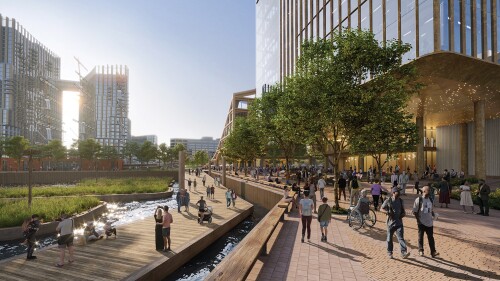ULI Philadelphia hosted an event discussing the America in 2015survey, with three local land use experts to respond to the Institute’s biennial survey on what people are looking for in the neighborhoods they choose.
Kathleen Carey, the keynote speaker and ULI’s chief content officer, provided an overview of the results of the report, which was distributed to attendees, and pointed out some of the data she found of particular interest.
Most people—87 percent overall—said they are happy with where they live, said Carey. The pockets of dissatisfaction seem to reflect populations with relatively less choice, such as those of lower socioeconomic status. Low-income respondents in city and rural/small-town settings tended to be more dissatisfied than suburbanites.
Related: View the Presentation | America in 2015
Many of the issues causing a lack of satisfaction cluster around barriers to healthy living, Carey said. People place a high priority on the quality of the environment, the availability of healthy food, and safe access to green space. There is increasing need for bike lanes and decreasing need for parking, she said.
Following Carey’s remarks, three local professionals involved in issues around development, greening, and gentrification had the opportunity to respond. They were asked how well the report’s results reflect their own observations, and also to comment specifically on the role of millennials.
David Waxman is a founder and the managing partner of MM Partners, which is developing in Brewerytown, a north Philadelphia neighborhood that turned residential when the dozens of breweries there disappeared in the wake of Prohibition. Its population became increasingly poor and minority as whites fled the city during the middle of the 20th century, but it has undergone gentrification during the last 20 years or so. It is a popular neighborhood with millennials.
Waxman’s experience is that although the millennials are an extremely important segment of the urban population, baby boomers also are moving into the city—whether they’re downsizing to condominiums or moving into urban mansions equipped with elevators. When one is building for millennials, he said, the main concern is providing convenient and appropriate retail—once that is in place, residents will follow. In 2008, his firm responded to the economic downturn by investing directly in small businesses to ensure the vitality of the mix. The challenge, he acknowledged, is to do so without displacing existing residents and businesses.
Brad Copeland is the executive director of Mt. Airy USA, a nonprofit organization devoted to corridor revitalization, real estate development, housing counseling, and public school partnerships in the northwest Philadelphia neighborhood of Mount Airy. It is considered one of the first successfully integrated neighborhoods in the United States, and continues to be recognized for its racial diversity. The Wissahickon Valley—one of the National Natural Landmarks of the United States and part of the city’s extensive Fairmount Park system—offers miles of running, bicycle, and equestrian trails and is one of the neighborhood’s most dramatic assets.
The importance of green spaces to respondents in the ULI survey is in line with Copeland’s observations. The Wissahickon is literally in the backyard of some Mount Airy homes, he said, and though other areas of the city also border on the park, Mount Airy residents considers it their own.
Millennials are not an important age segment in Mount Airy, Copeland said—there has been an increase of only about 400 (out of a total population of around 27,000, according to the 2010 U.S. Census) over the last five years. Gen Xers raising families are more apt to be attracted to the healthy stock of single-family homes in the neighborhood.
Tammy Leigh Dement is the associate director of civic landscapes for the Pennsylvania Horticultural Society (PHS), which has a long history of providing support to gardeners of all kinds across the city. PHS has proved to be an important resource for groups wanting to start community gardens on vacant lots. Those community gardens, Dement said, are often started to provide fresh produce to those living in low-income “food deserts.”
People are deeply concerned with what happens to vacant land in their neighborhoods, she said. She described a ten-year battle over a particular plot that a developer wanted to build on and the current residents wanted to keep as a park. After the issue was resolved in favor of keeping the space green, the developer built nearby and marketed the project boasting about its proximity to the park.
Dement reported that although many of the people engaging with PHS are seniors—a number she anticipates will increase disproportionately over the next five years—she also sees a lot of volunteerism among millennials who are preparing their neighborhoods for their own futures. “They say, ‘When I have kids, they’ll be able to go to this park,’ ” she said.




